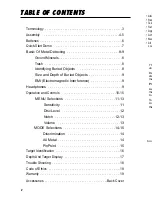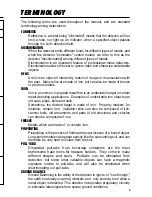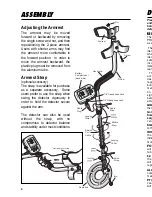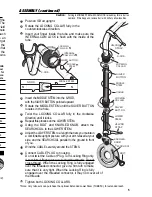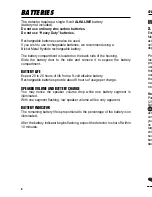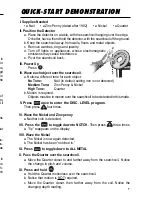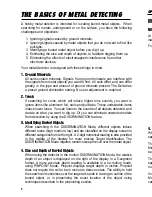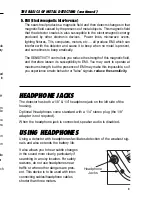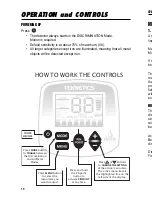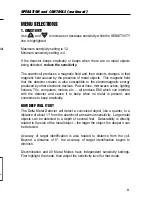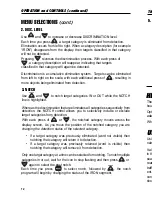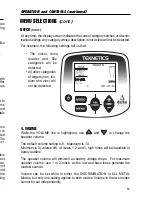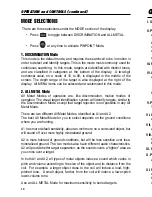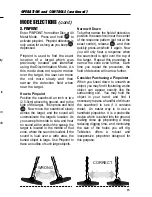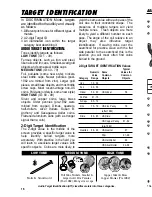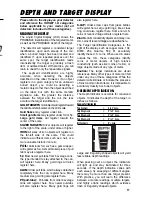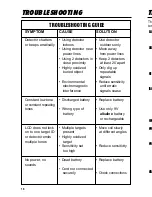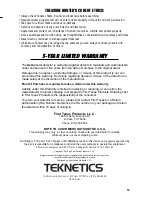
17
4
ASSEMBLY
Adjusting the Armrest
The armrest may be moved
forward or backward by removing
the single screw and nut, and then
repositioning the 2-piece armrest.
Users with shorter arms may find
the armrest more comfortable in
the forward position. In order to
move the armrest backward, the
plastic plug must be removed from
the aluminum tube.
Armrest Strap
(optional accessory)
The strap is available for purchase
as a separate accessory. Some
users prefer to use the strap when
swing the detector vigorously in
order to hold the detector secure
against the arm.
The detector can also be used
without the strap, with no
compromise to detector balance
and stability under most conditions.
Hand-grip
Nut
Screw
Search
Coil
Cable
Cable
Plug
Searchoil
S-Rod
Armrest
Velcro
Strap
Middle
Stem
Velcro
Strap
Locking
Collar
Locking
Collar
Battery
Compartment
(back side)
1/8” Headphone Jack
1/4” Headphone Jack
Optional Arm Strap
DEPTH AND TARGET DISPLAY
Please refer to the display on your detector
and reference the TARGET I.D. categories
below applicable to your model (not all
detectors include all of these categories).
READING THE DISPLAY
The Liquid Crystal Display (LCD) shows the
PROBABLE identification of the targeted metal,
as well as the PROBABLE depth of the target.
The detector will register a consistent target
identification, upon each sweep of the coil,
when a buried target has been located and
identified. If, upon repeated passes over the
same spot, the target identification reads
inconsistently, the target is probably a trash
item, or oxidized metal. With practice, you will
learn to unearth only the repeatable signals.
The segment identifications are highly
accurate, when detecting the objects
described on the label. However, if an object
registers in a given category for an unknown
buried object, you could be detecting a
metallic object other than the object described
on the label, but with the same metallic
signature. Also, the greater the distance
between the target and the coil, the less
accurate the target identification.
GOLD TARGETS
Gold objects will register toward
the middle or left-of-center on the LCD scale.
Gold flakes may register under iron.
Small gold items may register under foil or 5¢.
Large gold items will register toward the
center of the scale.
SILVER TARGETS:
Silver objects will register
to the right of the scale, under dime or higher.
IRON:
All sizes of iron objects will register on
the far-left side of the scale. This could
indicate a worthless item such as a nail, or a
more valuable historic iron relic.
FOIL:
Aluminum foil, such as a gum wrapper,
will register as foil. A small broken piece of pull
tab may also register here.
5¢:
Most newer pull-tabs from beverage cans,
the type intended to stay attached to the can,
will register here. Many gold rings will also
register here.
ALUM:
Older pull tabs, which always detached
completely from the can, register here. Many
medium size gold ring also register here.
PT(pull-tabs):
Pull-tabs from older beverage
cans will register here. Few newer pull-tabs
will also register here. Many gold rings will
also register here.
S-CAP:
Older screw caps from glass bottles
will register here. Large gold rings, like a class
ring, could also register here. Some non-U.S.
coins of recent vintage will also register here.
Zinc:
Medium conductivity objects and many non-
U.S. coins of recent vintage are classified here.
The Target Identification Categories to the
right of the display, such as copper coins, 10¢,
DIME, 25¢, Quarter, 50¢, $1 accurately
identify these U.S. coins. When used in areas
outside the U.S., these categories identify
coins or metal objects of high relative
conductivity (such as silver coins or relics), or
large objects made of any type of metal.
Caution:
The target indications are visual
references. Many other types of metal can fall
under any one of these categories. While the
detector will eliminate or indicate the presence
of most common trash items, it is impossible to
accurately classify ALL buried objects.
5-SEGMENT DEPTH INDICATOR:
The Depth Indicator is accurate for coin-sized
objects. It indicates the depth of the target, in
inches as follows:
Segments Illuminated
Top
Segment
=
0 to 2” deep.
Top 2
Segments
=
2” to 3” deep.
Top 3
Segments
=
4” to 5” deep.
Top 4
Segments
=
6” to 7” deep.
All
Segments
=
8”+ deep.
Large and irregularly-shaped objects will yield
less reliable depth readings
When passing over an object, the indicators
will light up and stay illuminated for three
seconds. If the depth indication varies with
each sweep, try sweeping at different angles;
there may be more than one target present.
With practice, you will learn the difference
between accurate readings, multiple targets,
and highly erratic readings which evidence
trash or irregularly shaped objects.


